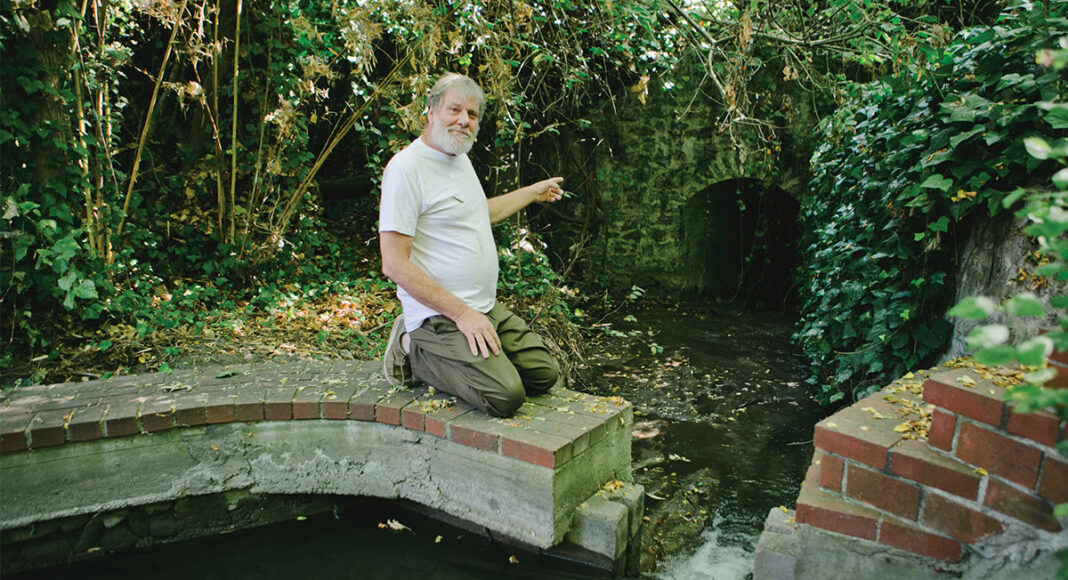Driving on Laurel Street during the two-and-a-half months of Westside construction has been an inconvenience for many Santa Cruz drivers, but one resident who lives near the PG&E work site at the top of Laurel Street hill says he spotted something more serious than a navigational irritant.
Silty excess asphalt has been piling up in the gutters along California and Laurel streets. David Callahan, an environmental activist and retired carpenter, is concerned that the dark sediment is falling directly into the nearby grates that lead down to Laurel Creek, a hidden, partially underground brook that wends its way to Neary Lagoon, and from there to the Monterey Bay.
There are four drains at the intersection that flow into the creek below. For the last two months, Callahan says he watched Snelson, the company contracted by PG&E, do nothing about the asphalt piling up in the gutters, so he started making phone calls to the city, county, and state agencies. He even tried to reach the federal Environmental Protection Agency.
“The level of their concern has been ‘We will respond to you as a citizen, but we don’t think it’s in our ballpark,’ or whatever. I find that completely shocking,” says Callahan, a 62-year-old with a scraggly white beard and a penchant for detailed storytelling, and once he gets going, it isn’t easy to slow him down.
Callahan remembers joining a tactical nonviolence training through the San Jose Peace Center to protest nuclear power in 1979 following the infamous Three Mile Island accident in Pennsylvania. The experience, he says, taught Callahan and his young classmates, who were just learning to question authority, how much power they have in the world. Ever since, he explains, Callahan has kept his eyes open for ways to make a difference in his immediate community. Laurel Creek runs through Callahan’s backyard, just upstream from the California Street work site and the Laurel Street hill.
Since his initial calls on Sept. 13, five county and city officials have made visits to the site, leading to a few attempts at corrections, such as sweeping up some but not all of the asphalt, he says. Crews recently put bright orange plastic filters over the gutters, eight weeks into the project, and two weeks after Callahan started making phone calls.
The city of Santa Cruz has a strict stormwater program that prohibits residents and businesses from discharging any pollutants including asphalt down the storm drains. Violations may be subject to up to $25,000 in fines.
Dave Martin, one of three environmental compliance inspectors at the city, paid the site a visit after Callahan reached out to him. “He phoned everyone,” Martin says of Callahan. Martin couldn’t find any evidence of a violation. He says that, yes, any amount of asphalt at all entering storm drains would be too much, but adds that it’s reasonable for a working construction site to move asphalt around during the active construction phase if they clean it up when the project is completed or before it rains.
Although rain totals have not been particularly high, it did rain a few times since construction began, for a total of a sixth of an inch over that time, according to the city’s water department. That’s a far cry from a winter storm, but more than enough to wet the ground a few times. Callahan says he also saw water from people washing their cars flow down the gutter into the grate, carrying the asphalt with it, in the weeks before crews installed the drain filters, which Callahan worries are too flimsy to keep out soot anyway.
When reached for follow-up, Martin says there are catch basins under each grate and that if any of them were to fill up with asphalt particles, city staff would force PG&E to clean them out.
In a statement, PG&E spokesperson Mayra Tostado says they responded to a formal complaint and found no violations. “Crews will continue to work safely to complete the project and protect the environment,” she writes.
According to a 1997 report from the National Parks Service, the main hazards from asphalt spills are its carcinogens and chemical compounds that can move through the ecosystem as the asphalt breaks down. “Asphalt,” it reads, “should be kept out of rivers, streams, and other natural waters to the extent possible.”
Some officials responding to Callahan’s calls claimed that what Callahan believed to be asphalt particles were probably only dirt. Skeptical of those suggestions, Callahan conducted an organic chemistry experiment in his garage, testing the solubility of the material with paint thinner and alcohol, proving that it was in fact, asphalt.
Laurel Creek, according to a 2008 analysis from the city, is, sure enough, an important riparian corridor, especially because it feeds Neary Lagoon, a critical wetland. “Although constrained by residential land uses, this reach is an important area for terrestrial and aquatic species due to its close proximity to the lagoon,” the report reads. “This reach offers some opportunity to enhance wildlife use and provide continuity to habitats within the lagoon.”
Callahan says he’s learned that environmental precautions should be part of any job site like the one on Laurel and California streets. “I’ve worked in construction sites where they have to wash the tires of the trucks off when they come off the construction site onto the road because they don’t want whatever is in the construction site to contaminate the drains, which can be outflows to the creeks, rivers, or the bay,” Callahan says. The first priority on a construction site, according to Callahan, is safety, followed only by environmental compliance.
In a follow-up email, Martin acknowledges that the project has been “very inconvenient” and knows that many people haven’t been happy about the construction. “However,” he writes, “PG&E is performing critical and necessary work, replacing a gas line to prevent real catastrophic loss of human life and property.”












